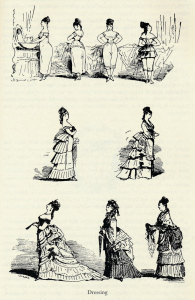I would like a few changes to be made to my portion of the Materials and their Makers project. I think a separate page for each type of fabric used in the body of clothing would be desirable. Right now, I have a brief description of silk, cotton, linen, and wool manufacturing on the landing page, but I think each one would benefit from its own page. I would like those pages to be linked to a world map, showing where the raw materials came from. The same could be done for the existing accessories pages (for ex., showing where the silver used in silver foil on buttons would have originated from). Pages on embroidery and tapestry would also be nice to add, particularly because the Met’s period rooms contain examples of those techniques.
Though my original vision did not come to pass, I still think it would be better to navigate my pages if various parts of one portrait (perhaps Mme. de Pompadour or Rose Ducreux) could be clicked on, taking viewers to specific pages. For example, a viewer could click on the tassels on the bottom of Ducreux’s dress and be sent to the tassels page. They could also click on the lace on her arm, and be sent to the lace page. Not only would this be a visually appealing way to navigate the website, but it would also help visitors to the site understand where each fabric detail would have been found on an outfit.
I also found a great image of all the layers of fabric that women would have worn (although it is from the 19th-century). It would be great to include this on a separate page to give viewers an idea of why the toilette was important and time-consuming (and might also be helpful for the Bodies in Space group). It would also help understand all the craftsmanship that went into creating clothing that was never seen in public. If there were a similar image for men’s outfits, it would also be nice to include. The image and citation are below:
Perrot, Philippe. Fashioning the Bourgeoisie: A History of Clothing in the Nineteenth Century. Translated by Richard Bienvenu. Princeton, New Jersey: Princeton University Press, 1994.
Finally, I would love to have found videos of how the objects were made (for ex, a video of someone using a loom, winding cord, etc.). It would compliment the plates nicely, and really give viewers a sense of how the workers made these objects. A video would help with our mission of bringing the makers back into the Met’s period rooms.
Overall, I have greatly enjoyed working on this project. All my group members and our TA have been enthusiastic about the project since the beginning, and it has been an absolute pleasure to work with all of them. I am excited to see where our project will go next, and look forward to the final result.
